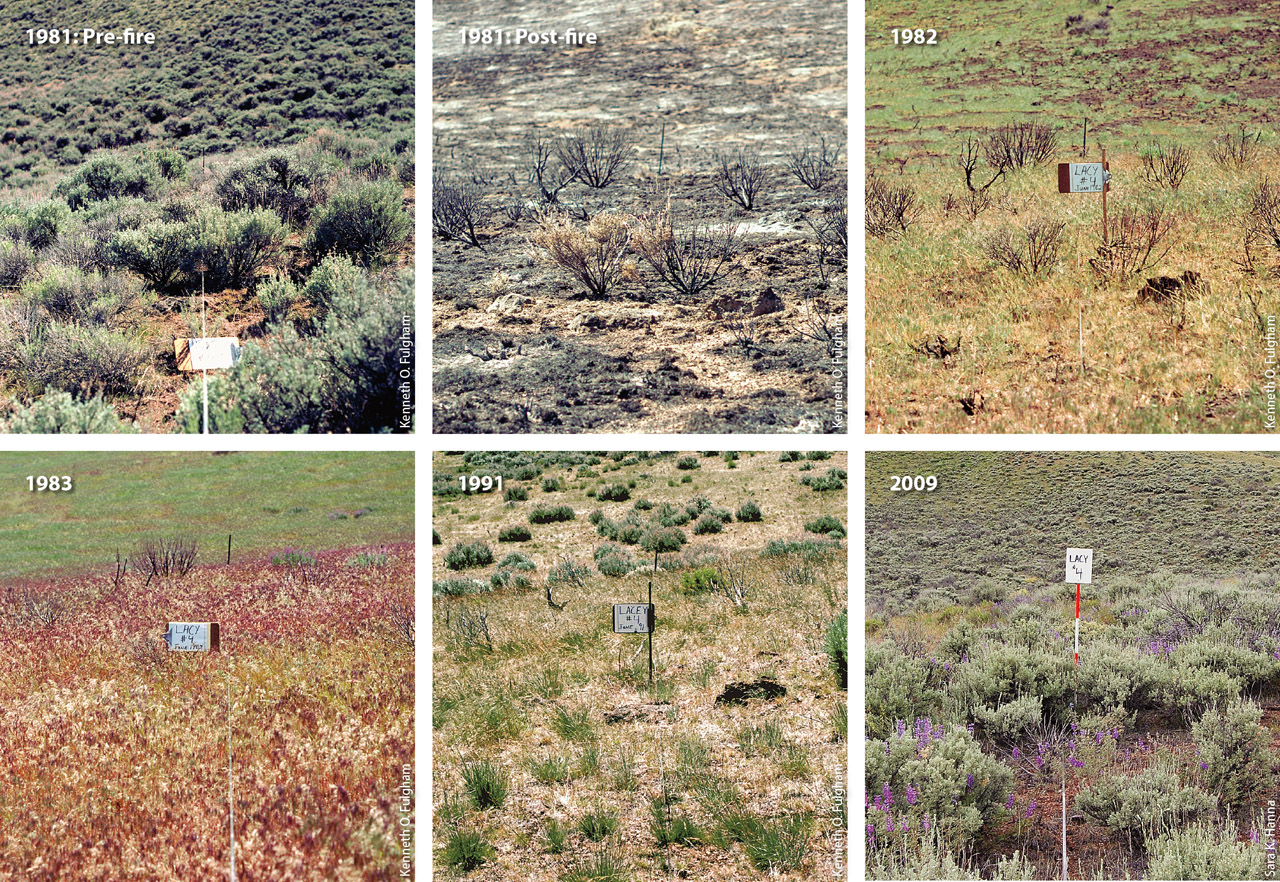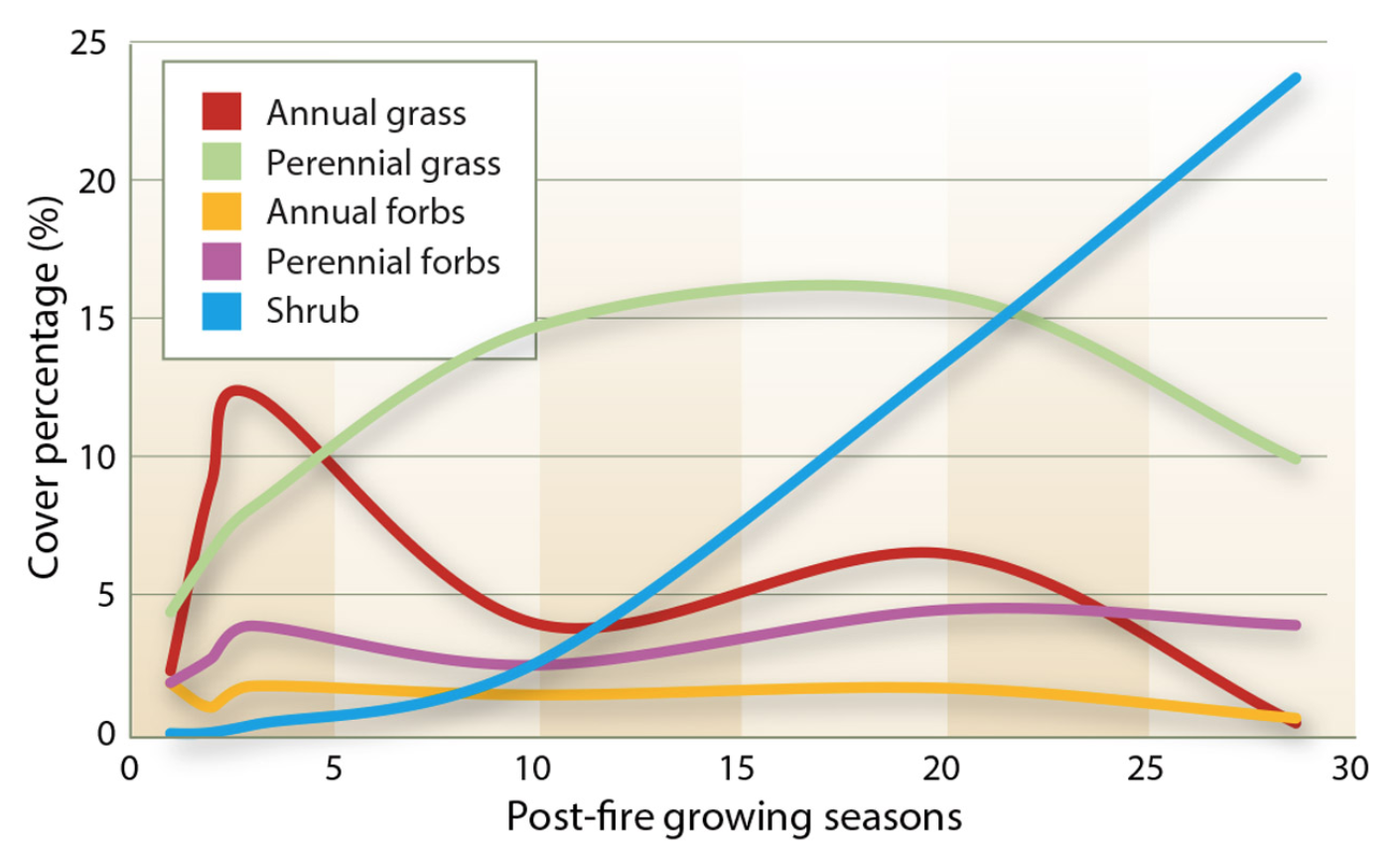Ecosystem Disturbance
The previous chapters provided a baseline of concepts and dynamics for a community on a linear successional path. Succession is community change over time toward a climax community. Successional communities are based in equilibrium: a balancing of populations and community dynamics based on competition, predation, and other species interactions. This chapter will focus on a dominant ecological driver in rangelands throughout the world—disturbance and retrogression.
Section 1: Ecosystem Disturbance
Ecosystem disturbance is an event or series of events altering the ecosystem structure and function, to be more specific: the removal of biomass and therefore ecosystem process. Disturbance affects plant composition, soil structure and function, hydrology, and nutrient cycling as well as intra- and interspecies interactions. In a nutshell, disturbance disrupts and alters the current successional trajectory.
Disturbance Types

There are dozens of types of disturbance, but they can be divided up into two primary categories—physical and biological—which can each then be broken down into natural occurrences or human-induced events.
Physical disturbances are disturbance events that alter the physical structure and arrangement of the landscape.

Physical disturbances usually occur swiftly in a short period of time; examples include a wildfire, flood, landslide, or volcanic eruption. Physical disturbances can also be human-induced events, such as plowing a field or clear-cutting a forest.
Biological disturbances are disturbance events that impact a species and community structure and function within an ecosystem.
They often occur through death—such as the effect of the mountain pine beetle (Dendroctonus ponderosae) on intermountain pine forests (figure 6.1)—or through dominance—such as the expanses of cheatgrass (Bromus tectorum) throughout the western United States (figure 6.2).
Characteristics of Disturbance Regimes
Disturbances vary across a number of characteristics that influence the degree of their impacts on ecosystem structure and function: frequency, spatial scale, timing, predictability, and synergism.
Understanding the frequency of the disturbance regime indicates the degree to which an ecosystem has time to recover or not. Disturbance frequency can be a one-time or rare event, such as a volcanic eruption or land conversion from a natural ecosystem to agriculture, establishing a road or well-pad site, or some other human use. Disturbances such as fires and floods recur at intervals, allowing periods of recovery, while hiking or off-road vehicle trail use or continuous year-round grazing are persistent disturbances that accelerate and exacerbate degradation because there is no period of recovery.
The spatial scale is the physical extent of the impacts of the disturbance on the landscape. It can vary from a couple of acres to thousands of acres. The spatial scale relates directly to the magnitude and severity of the disturbance, as well as to the management options to mitigate impacts or undertake restoration efforts. For example, ten acres used as a holding area for cattle twice a year could become infested with invasive species. Once established, invasive species could aggressively spread, particularly if facilitated by wind or drought. The impacts of this invasive species infestation would increase slowly over time. On the other hand, a fire that burned thousands of acres has an immediate impact on the ecosystem structure and function.
The timing or season of a disturbance is the point in the area’s climatic regime, plant season of growth, or wildlife reproduction cycle at which the disturbance occurs or is most intense. For example, a fire in the middle of a hot dry windy summer is different than a late fall fire just prior to a period of cooler temperatures and increased precipitation. Plowing a field in spring or early summer prior to invasive plant seed production will minimize seed disbursement, whereas plowing in midsummer or fall will facilitate seed disbursement. Cutting a road through sagebrush, specifically a lek site, to a well-pad site during sage grouse mating season will reduce the reproductive rate for that year.
Disturbances tend to be viewed through a lens of uncertainty, but in reality, disturbances can have a degree of predictability. A grass valley several years into a drought will have more fine fuels, and as such is more likely to catch fire and burn intensely than if previous and current years’ precipitation is average and the valley is managed through grazing or mowing to reduce fuel load buildup. Understanding disturbance ecology, invasive species biology, and fire science underlie disturbance predictability and management actions to prevent, control, and mitigate.
With each disturbance, all the aforementioned characteristics combined determine the extent, magnitude, and severity of the disturbance. These characteristics, combined with interconnected impacts (some of which are discussed below), create a synergy that amplifies positive feedback loops and ripple effects within an ecosystem. A common example is the invasion of juniper and increasing degradation of soil stability, hydrologic function, and biotic integrity. Not only is the invaded juniper area impacted, but the surrounding shrubland and grassland areas in terms of hydrology, plant and wildlife composition, and nutrient cycling are as well.
Disturbance Impacts on Ecosystem Structure and Function
There are a multitude of impacts on ecosystems post-disturbance, all of which depend on the type of system, the disturbance, and the system’s degree of resiliency (covered in chapter 7). This section will highlight impacts on several key ecosystem functions and ecosystem biodiversity.
Disturbance has varying effects on nutrient cycles. Fire can initially accelerate and amplify the carbon and nitrogen cycles through the accelerated decomposition of above- and belowground biomass, depending on the intensity of the fire. Drought, which reduces biomass production and in some systems maintains many species in a semidormant state, can inhibit and decrease carbon and nitrogen cycles. Invasive species can also greatly affect these cycles, particularly nitrogen, as in nitrogen-saturated or -limited environments, as many invasive species have the ability to acquire soil nitrogen quickly and use it efficiently, thus giving the invasive species an advantage over native species. One of the reasons invasive species tend to dominate post-cultivation is due to the low nutrient levels, as cropped systems over time deplete soil nutrients and microbial communities.
Hydrologic function, in which water is captured, stored, and released safely in a system, requires biotic integrity and soil stability. The vegetative structure of an ecosystem plays a critical role in the capture of water. Infiltration of water from a precipitation event is greatly reduced and runoff greatly increased in a system with minimal vegetative canopy. Belowground, a system dominated by shallow-rooted species also reduces the capture and storage of water. Soil structure and stability are often degraded post-disturbance, exacerbating soil erosion and loss of soil organic matter and minerals.
Biodiversity is often the most evident impact of a disturbance. Depending on the type, timing, and spatial scale of the disturbance the influence on biotic integrity can be locally focused and gradually increase (e.g., invasive species establishment and proliferation) or widespread and swift (e.g., fire or flood). The end result of either path is often shifts and/or reductions in biodiversity throughout the ecosystem. Not only the vegetation composition but also the structure of the vegetation influencing the habitat of small mammals and ground-nesting birds and the density of foraging ungulates may change. Soil structure (density and ped stability) may change, altering hydrology; soil organic matter, nutrient cycling, and soil microbial community composition and productivity may be altered or reduced, all of which can further impact biotic integrity and diversity.

Disturbance is fairly ubiquitous, so much so that we have management methods and models that focus on disturbance, such as state and transition models (see the example at the end of this chapter). Before we move on to understanding retrogression and modeling impacts of disturbance, we will look at intermediate disturbance hypothesis (IDH), which suggests that, under a disturbance regime (frequency of disturbance), species diversity is highest with a moderate disturbance regime (figure 6.3). What defines moderate depends on the ecosystem, the type of disturbance, and its characteristics.
Why is it that moderate disturbance can result in a higher level of biodiversity? Moderate disturbance serves to facilitate a retrogression-successional cycle in an ecosystem. This retrogression-successional cycle maintains balance among species densities. For example, we often hear how fire suppression results in woody species encroachment and that brush management through prescribed fire or mechanical means opens up niches for an increase in grasses and forbs.
Frequent high-intensity disturbance maintains an ecosystem in an early successional state. In the arid West, where water and nutrients can be limited, maintaining a system in an early successional state often facilitates invasive species establishment and proliferation. A synergy can develop between a frequent high-intensity disturbance such as fire and the invasive species; this not only maintains the system in an early successional state but also exacerbates spiraling degradation of the system. The fire–cheatgrass (Bromus tectorum) cycle is a class example of this dynamic.
Infrequent low-intensity disturbance tends not to facilitate an adequate degree of shifting of vegetation composition and structure, soil processes, and animal communities to achieve rebalancing. Under low intensity or infrequent disturbances, open niches are few to none, and competitive exclusion remains the status quo. The aforementioned woody species encroachment serves as an example of how infrequent low-intensity disturbance maintains competitive exclusion for species such as juniper (Juniperus occidentalis) and sagebrush (Artemisia tridentata).

Moderate intensity or frequency disturbance results in the highest level of biodiversity because an adequate degree of structure and processes are altered, increasing available resources and opening niches. In systems with moderate disturbance, niches open for colonization, while established species with tolerances and competitive advantages remain. As we can see from figure 6.5 a dense sagebrush system was “reset” to rebalance to a mix of shrubs, forbs, and perennial grasses. The graph in figure 6.3 conveys how the system rebalanced over the twenty-seven-year period following the fire.
Figure 6.4 shows how this ecosystem was able to rebalance to a vegetation composition dominated by perennial grasses (green curve) as shown on the graph (figure 6.5) rather than a system dominated by annual grasses. The answer lies in the concept of resiliency, the focus of chapter 7.


